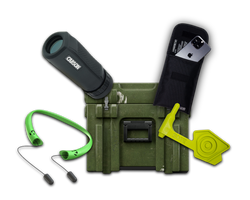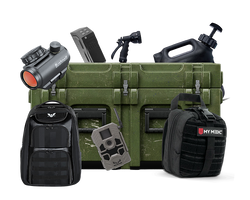What is a Cartridge Case? Understanding Its Role in Firearms
Table of Contents
- Introduction
- What Makes Up a Cartridge Case?
- Materials Used in Cartridge Cases
- Types of Cartridge Cases
- How Cartridge Cases Work
- The Importance of Quality Cartridge Cases
- Conclusion
- FAQs
Introduction
Imagine a world where loading a firearm meant meticulously measuring gunpowder and manually inserting projectiles with the utmost care—a tedious process that drastically slowed down the rate of fire. The invention of the cartridge case revolutionized this landscape, creating a streamlined method for loading firearms that forever changed the dynamics of shooting sports and warfare. Today, the cartridge case serves multiple essential functions, from housing the projectile and propellant to facilitating ignition and enabling extraction after firing. But what exactly is a cartridge case, and why is it so crucial?
In this blog post, we will delve into the intricacies of cartridge cases, exploring their history, structure, materials, and various types. We aim to provide a comprehensive understanding of how they work and their significance in the world of firearms. By the end, you will not only grasp what a cartridge case is but also appreciate its role in enhancing performance, safety, and reliability in shooting.
Historical Context of Cartridge Cases
The journey of the cartridge case spans centuries, beginning with the early days of gunpowder weapons. Before their invention, soldiers relied on loose powder and separate projectiles, a method that was inefficient and cumbersome. The need for a more efficient system led to the development of the cartridge, which integrated all essential components into a single unit.
The first metallic cartridges emerged in the early 19th century, with innovations such as the pinfire and rimfire systems laying the groundwork for modern designs. These early cartridges faced challenges, including reliability and gas sealing. Over time, advancements in metallurgy and manufacturing techniques culminated in the creation of the robust cartridge cases we use today.
In this article, we will explore the evolution of cartridge cases, their different types, and the materials used in their construction. We will highlight how each of these elements contributes to the overall functionality and reliability of firearms.
What Makes Up a Cartridge Case?
A cartridge case is a critical component of modern ammunition, and it consists of several parts that work together seamlessly to ensure effective firing. Here’s a breakdown of the main components:
1. The Case
The cartridge case itself is the outer shell that contains all other components, including the bullet, propellant, and primer.
-
Shape and Design: Most modern cartridge cases are metallic and come in two main shapes: bottleneck and straight-walled. Bottleneck cases feature a tapered design that helps guide the bullet into the chamber, while straight-walled cases have a uniform diameter throughout their length.
-
Functionality: The case acts as a barrier to contain the pressure generated when the propellant ignites, allowing for the efficient transfer of energy to launch the projectile.
2. The Projectile
The projectile is the part of the cartridge that is expelled from the firearm upon firing. It can vary significantly in design, weight, and material, depending on the intended use—be it hunting, target shooting, or self-defense.
3. The Propellant
Propellant is the chemical mixture within the cartridge that ignites and creates the gas pressure needed to propel the projectile. Modern firearms primarily use smokeless powder, which provides higher energy density and produces less smoke than traditional black powder.
4. The Primer
The primer is a small explosive charge located at the base of the cartridge case. When struck by the firing pin, it ignites and sends a flame into the case to ignite the propellant. There are two primary types of primers used in modern ammunition: centerfire and rimfire.
5. The Rim
The rim of the cartridge case serves as the extraction point. Depending on the design, it can be rimmed, rimless, or semi-rimmed. This feature allows the firearm's extractor to grasp the case and pull it from the chamber after firing.
Materials Used in Cartridge Cases
The material used for cartridge cases significantly impacts their performance, durability, and cost. Here are the most commonly used materials:
1. Brass
Brass is the most popular material for cartridge cases due to its excellent corrosion resistance, malleability, and ability to withstand high pressures. Brass cases can be easily reloaded, making them a favorite among enthusiasts and competitive shooters.
2. Steel
Steel is often used for budget ammunition or military applications. While it is less expensive than brass, it is also less corrosion-resistant and not typically reloadable. Steel cases can sometimes pose extraction issues due to their rigidity.
3. Aluminum
Aluminum cases are lightweight and cost-effective, often used in high-volume shooting situations. However, they are generally not reloadable due to their tendency to deform during firing.
4. Plastic
Plastic cases are primarily used in shotgun shells, which combine cardboard or plastic with a metal base. They are lightweight and resistant to moisture, making them suitable for various weather conditions.
Types of Cartridge Cases
Cartridge cases come in various designs, each tailored to specific firearms and uses. Here are the most common types:
1. Rimfire Cartridges
Rimfire cartridges have the primer located in the rim of the case. They are primarily used for small-caliber ammunition, such as .22 LR. While rimfire options are often less powerful, they are widely popular for training and recreational shooting due to their lower cost.
2. Centerfire Cartridges
Centerfire cartridges feature a primer located at the center of the case head. This design allows for higher pressures and is suitable for most modern firearms, including rifles and handguns. The centerfire system has become the standard for military and law enforcement ammunition.
3. Shotshells
Shotshells are a unique type of cartridge designed for shotguns. They typically consist of a plastic or cardboard case containing multiple small pellets or a single slug. The design allows for a wider spread of shot, making them ideal for hunting birds and other small game.
4. Specialty Cartridges
Various specialty cartridges exist for specific purposes, such as blank rounds, dummy rounds for training, or non-lethal options like rubber bullets. Each of these types features unique designs and functionalities tailored to their intended applications.
How Cartridge Cases Work
Understanding how a cartridge case works requires knowledge of the firing cycle. Here’s a step-by-step breakdown:
1. Loading the Cartridge
The cartridge is loaded into the chamber of the firearm, aligned with the barrel. In semi-automatic and automatic firearms, the action cycles automatically, loading a new cartridge with each trigger pull.
2. Ignition
When the trigger is pulled, the firing pin strikes the primer at the base of the cartridge case. The primer ignites, producing a small flame that travels into the case and ignites the propellant.
3. Expansion and Launch
As the propellant ignites, it generates rapidly expanding gases, creating high pressure within the cartridge case. This pressure pushes the projectile out of the barrel at high velocity.
4. Ejection
After firing, the cartridge case expands due to the pressure. Once the bullet exits the barrel, the pressure inside the case drops, allowing the case to contract slightly. The extractor engages the rim of the case, pulling it out of the chamber and ejecting it to make room for a new cartridge.
The Importance of Quality Cartridge Cases
Using high-quality cartridge cases is crucial for achieving optimal performance and safety in shooting. Here are several reasons why investing in quality matters:
1. Consistency and Accuracy
Quality cartridge cases ensure consistent performance, allowing for predictable velocities and trajectories. This consistency is vital for competitive shooters who rely on precision.
2. Safety
Well-manufactured cartridge cases minimize the risk of failures such as ruptures or misfires. This reliability is essential for maintaining safety in shooting environments.
3. Reloadability
For those who reload their ammunition, high-quality cases are crucial. Brass cases, in particular, can be resized and reused multiple times, providing a cost-effective solution for avid shooters.
Conclusion
In summary, the cartridge case is a vital component in the world of firearms. Its design, materials, and functionality play a significant role in the overall performance of ammunition. Understanding what a cartridge case is and how it works can enhance your appreciation for firearms and shooting sports.
As you engage with this fascinating subject, consider the importance of quality gear and tools in your own tactical and survival endeavors. At Crate Club, we emphasize the value of high-quality, reliable equipment, ensuring you are always prepared for any situation. Explore our subscription services and shop for gear that aligns with your tactical needs:
FAQs
What materials are cartridge cases made from?
Cartridge cases are commonly made from brass, steel, aluminum, or plastic, each with its own benefits and applications.
Can I reload all types of cartridge cases?
Not all cartridge cases are reloadable. Brass cases are typically the most suitable for reloading, while steel and aluminum cases may not be reusable.
What are the differences between rimfire and centerfire cartridges?
Rimfire cartridges have the primer located in the rim of the case and are generally lower pressure, while centerfire cartridges have the primer in the center of the case head, allowing for higher pressure and more powerful ammunition.
How do I ensure the quality of my cartridge cases?
Invest in reputable brands and manufacturers that prioritize quality control. Look for cases that are designed for reloading if you plan to reuse them.
What is the purpose of the primer in a cartridge case?
The primer ignites the propellant when struck by the firing pin, initiating the firing process and propelling the projectile out of the barrel.
By understanding the intricacies of cartridge cases and their role in firearms, you can make informed choices about your equipment and ammunition, ensuring you are always ready for your next adventure.
แบ่งปันบทความนี้



